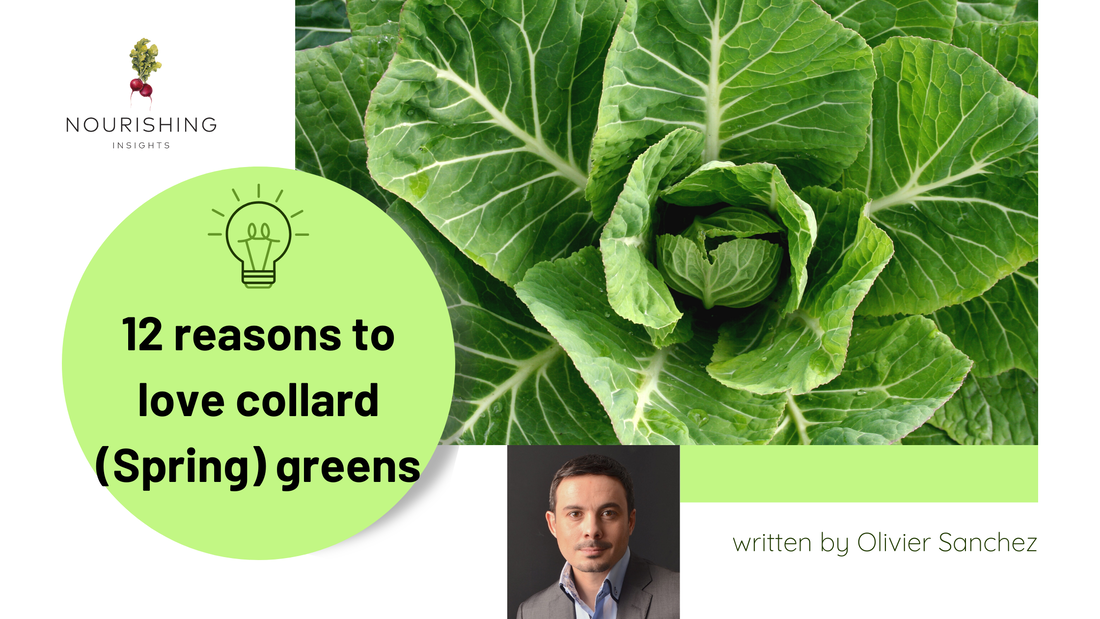|
Collard greens are leafy, dark green vegetables (cruciferous) and belong to the Brassica genus of plants, which also include broccoli, Brussel sprouts, cabbage, cauliflower, kale, kohlrabi and mustard greens. For hundreds of years, collard greens have been traditionally used in Southern American cooking and the ancient Greeks cultivated several forms of both collard greens and kale. Unlike cavolo nero or kale’s curly, narrow leaves, collard greens’ leaves are large, smooth, and flat. Known as spring greens in the UK, they’re pretty much unloved and are far from receiving the same recognition as collard greens in the US. Yet they are packed with nutrients, scoring the highest on the ANDI list — together with kale. Nutrition Facts:
Collard greens are an excellent source of vitamin K and are very rich in vitamin A and C, folate and manganese. They also contain good levels of calcium. They’re also rich in soluble fibre and display strong antioxidant properties, making them ideal contestants in an anti-inflammatory diet. Additionally, they support liver function and support glutathione pathways. Glutathione is one of the most important antioxidant enzymes in the body (derived from glutamic acid, cysteine and glycine), preventing damage caused by free radicals (oxygen reactive species), peroxides, and heavy metals. It is essential to detoxification processes and facilitates the metabolism of xenobiotics. In itself, glutathione displays anti-cancer properties.1 Additionally, collard greens are rich in sulfur-containing compounds called glucosinolates, essential to support liver detoxification pathways, and indole-3-carbinol, which are known to reduce the risk of breast, colon and lung cancer. Health benefits: 1. Support cellular and liver detoxification Collard greens are rich sources of sulphur-containing compounds called glucosinolates, pigments that give their rich green colour as well as a bitter taste. Glucosinolates and their breakdown derivatives (metabolites), especially isothiocyanates and indole-3-carbinol, exert a variety of biological activities that may be relevant to health promotion and disease prevention in humans. They are particularly known for their antioxidative activities and their anti-inflammatory and immunoprotective properties. They support liver function as well as cellular detoxification pathways. They may also inhibit the growth of H. pylori (sulforaphane). Chopping collard greens allow for enzymatic processes that break down glucosinolates into their metabolites. Once absorbed by gut cells, isothiocyanates are used to produce glutathione (the most important antioxidant enzyme) in the liver. 2. Support bone mass Extremely rich in bone-building vitamin k and a good source of calcium, collard greens can increase bone mineral density and reduce the risk of fracture. 3. Support cardiovascular health The high concentrations of vitamin K, one of the most crucial vitamins for preventing heart disease, can lower the risk of cardiovascular mortality. Vitamin K deficiency has been linked to IBS, heart disease, weakened bones, and cancer. 4. Support eye health and help maintain good vision Extremely rich in vitamin A, a fat-soluble compound, collard greens are a great choice to help maintain healthy vision, neurological function and healthy skin (also helps reduce the signs of early ageing and poor completion. In fact, both could be signs of deficiency. Another sign of deficiency is poor visibility in the dark). The most important characteristic of vitamin A is the part it plays as a powerful antioxidant, playing a pivotal role in free radical scavenging and keeping inflammatory processes under control. 5. Inflammation and cancer prevention Collard greens, as all members of the brassica family of vegetables, are unparalleled sources of phytonutrients (pigments), bioactive compounds found in plants that display antioxidant, anti-obesity, anticancer, antimicrobial, hepatoprotective, cardioprotective, gastroprotective, anti-anaemic, immunomodulating, and anti-inflammatory properties and are shown to have many health benefits. They may also help lower inflammation and reduce the risk of developing most cancer and may help reduce signs of early ageing. 6. Lowers (the bad) cholesterol High in fibre, collard greens can help lower LDL (the bad) cholesterol — without affecting the level of HDL (the good) cholesterol — by preventing cholesterol reuptake from the digestive tract. Cholesterol is produced by the liver to channel toxins out of the body via the bowel. A diet low in fibre and a dysbiotic gut milieu may allow for toxins and cholesterol to re-enter the circulation and affect the ratio of good and bad cholesterol, become oxidised and participate in plaque formation in the arteries. Adding more collard greens to your diet is likely to increase your fibre intake. Fibre can improve your digestive health by promoting regularity and feeding healthy gut bacteria and supporting the production of short-chain fatty acids, byproducts essential to keep the intestinal wall tight and permeable. 4 7. Support digestive function with gastroprotective effect It appears that compounds in brassicas, particularly sulforaphane, protect the gastric lining from oxidative stress associated with the development of gastritis and may prevent infection with H.pylori and may also support the body fighting the infection and further damage, including peptic ulcers and gastric cancer.5,6,7 8. Prevent birth defects Brassicas, including collard greens, are the most-revered natural sources of folate. Folate is an important vitamin that is essential for cell function and cell detoxification and is shown to play an important part in DNA synthesis and in the protection of our DNA. It also helps your body grow and is particularly important for young children and pregnant women. Folate intake must be supervised during pregnancy and it is recommended to consume at least 400 micrograms of folate daily — before conceiving and during pregnancy — in order to help prevent birth defects like spina bifida. 9. Support the immune system As already exposed, collard greens contain high levels of vitamin A and vitamin C, both of which are important to your immune system. Vitamin C helps keep your blood cells healthy and vitamin A is important for healthy T-cells. T cells play a critical part in immunity to foreign substances and as such can attack invading bacteria and viruses. 10. Help prevent anaemia Collard greens are a good source of iron. Its absorption is greatly increased with the folate present in collard greens, which also helps the body build more red blood cells, and reduce signs of fatigue and weakness associated with poor oxygenation of tissues, including the brain. 11. Help maintain blood sugar levels The dietary fibre in collard greens helps maintain a balanced glucose level, which can help manage insulin resistance and prevent diabetes. The alpha-lipoic acid present in collard greens helps lower plasma glucose levels and increases insulin sensitivity. 12. Promote relaxation Extremely rich in chlorophyll (a molecule with magnesium at its core), collard greens appear to have calming effects on the central nervous system. They may also help with sleeping problems and improve memory and, therefore, may improve mood. Collard greens can also relax sore muscles after intense exercise. References: 1 Balendiran, GK. Dabur, R. Fraser, D (2004). The role of glutathione in cancer. Cell Biochemistry and Function. 22(6), pp. 343–52. doi:10.1002/cbf.1149 2 Favela-González, KM. Hernández-Almanza, AY. De la Fuente Salcido, NM. (2020). The value of bioactive compounds of cruciferous 2 vegetables as antimicrobials and antioxidants: A review. Journal of Food Biochemistry. 44(10), e13414. doi:10.1111/jfbc.13414 3Source:https://www.cancer.gov/about-cancer/causes-prevention/risk/diet/cruciferous-vegetables-fact-sheet 4 Myhrstad, M. et al. (2020). Dietary fiber, gut microbiota, and metabolic regulation — current status in human randomized trials. Nutrients. 12(3), 859. doi.:10.3390/nu12030859 5 Chang, YW. et al. (2015). The effects of broccoli sprout extract containing sulforaphane on lipid peroxidation and Helicobacter pylori infection in the gastric mucosa. Gut Liver. 9(4), pp. 486–493. doi:10.5009/gnl14040 6 Yanaka, A. et al. (2009). Dietary sulforaphane-rich broccoli sprouts reduce colonization and attenuate gastritis in Helicobacter pylori- infected mice and humans. Cancer prevention research (Philadelphia, Pa.). 2(4), pp. 353–60. doi:10.1158/1940-6207.CAPR-08-0192 7 Fahey, JW. et al. (2013). Urease from Helicobacter pylori is inactivated by sulforaphane and other isothiocyanates. Biochemical and 7 biophysical research communications. 435(1), pp. 1-7. doi:10.1016/j.bbrc.2013.03.126
2 Comments
Rita Annan-Brady
22/3/2024 07:52:02 pm
Actually collards are not known as spring greens in UK. They are similar but not the same. UK does not have collards; US does nor have spring greens. And the British LOVE spring greens.
Reply
Leave a Reply. |
Amazon Associates DisclosureNourishing Insights is a participant in the Amazon EU Associates Programme, an affiliate advertising programme designed to provide a means for sites to earn advertising fees by advertising and linking to Amazon.co.uk. Archives
December 2023
|
WHAT OUR CLIENTS ARE SAYING“I did Nutritional Therapy with Beverley and it was life changing. I highly recommend it!” Allison Blakely (Glasgow)
|
Contact Us |



